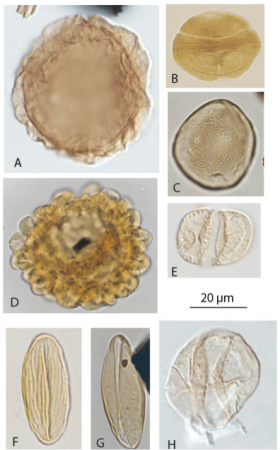 Nina Baghai-Riding, professor of biology and environmental science at Delta State, recently presented on plants of the Late Jurassic Morrison Formation, including these typical pollen types from the era.
Nina Baghai-Riding, professor of biology and environmental science at Delta State, recently presented on plants of the Late Jurassic Morrison Formation, including these typical pollen types from the era.Nina Baghai-Riding, professor of biology and environmental science at Delta State, recently provided a presentation to the Memphis Archaeological and Geological Society (MAGS) focusing on the plants of the Late Jurassic Morrison Formation.
“I have been working on the plants from this geological unit since 2007 with my colleague Dr. Carol Hotton from the National Museum of Natural History, Smithsonian Institution, Department of Paleobiology,” said Riding.
The Morrison Formation is a vast terrestrial deposit extending over parts of 13 states, spanning from northern New Mexico and Arizona, Oklahoma, Texas, Utah, Colorado, Kansas, Nebraska, Wyoming, Idaho, Montana, South Dakota, North Dakota and into equivalent units into Alberta, Canada.
It ranges from 34–50 degrees north latitude. This unit also has a vast temporal range (160–145 M.A.) and is particularly known for its large dinosaurs such as stegosaurs, camarasaurs, allosaurs, diplodocus and more.
“Dr. Hotton and I have been trying to determine what the large plant eating herbivores consumed,” added Riding. “For the most part, finding good plant localities are rather rare throughout this unit. Only about 30 plant sites have been reported.”
The plants are preserved as compressions and impressions, petrification — such as petrified wood — and as compactions known as palynomorphs. Palynomorphs include fossil pollen, spores and algal cysts.
“To date, we have found over 110 different morphospecies, species based on either just leaves, wood or palynomorphs. Plant groups that have been found include mosses, ferns, conifers, ginkgoes, cycads, and more. Flowering plants including palms, water lilies, grasses, oaks, and magnolias were not around yet.
“We have established that arborescent conifers were regionally dominate and ferns served as an important understory.”
Understanding the different plant life has helped Riding and Hotton establish information about what the climate was like throughout the history of the Morrison.
“From the palynomorphs we have determined that the climate was seasonally dry and frost-free,” said Riding. “Distinct south to north and east to west gradients of increasing species richness and in spore abundance also was observed.”
Riding’s talk was featured in the June MAGS newsletter and is viewable at http://www.memphisgeology.org/images/rocknews0614.pdf.

